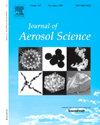机器学习算法促进了海盐气溶胶光散射特性的快速推导
IF 3.9
3区 环境科学与生态学
Q2 ENGINEERING, CHEMICAL
引用次数: 0
摘要
考虑环境相对湿度(RH)对海盐气溶胶光学性质的影响通常需要复杂且耗时的光散射计算。为了促进这一过程,本研究采用机器学习算法快速获取任意粒径、RHs和波长下海盐气溶胶的单次散射特性(包括消光效率、散射效率、单次散射反照率和不对称因子)。根据环境相对湿度,将海盐颗粒建模为涂层球或均匀球,并使用不变嵌入t矩阵方法计算其在选定尺寸、波长和RHs下的散射特性,以建立用于训练和验证目的的数据集。广泛的测试使用各种机器学习方法和超参数优化实现。结果表明,基于Optuna调优的梯度增强决策树方法在预测海盐气溶胶散射特性方面优于其他方法。所开发的模型有望用于涉及海盐气溶胶的辐射传输应用,并且类似的方法可能潜在地应用于需要快速获取气溶胶光学特性的其他场景。本文章由计算机程序翻译,如有差异,请以英文原文为准。
Machine learning algorithm facilitates fast derivation of light-scattering properties of sea salt aerosol
Accounting for the impacts of ambient relative humidity (RH) on the optical properties of sea salt aerosols usually requires complex and time-consuming light-scattering computations. To facilitate the process, this study employs machine learning algorithms to gain fast access to the single-scattering properties (including extinction efficiency, scattering efficiency, single-scattering albedo, and asymmetry factor) of sea salt aerosols at arbitrary particle sizes, RHs and wavelengths. The sea salt particles are modeled as either coated-spheres or homogeneous spheres depending on the ambient relative humidity, and their scattering properties are calculated using the invariant imbedding T-matrix method at selected sizes, wavelengths, and RHs to establish a data set for the training and validation purposes. Extensive tests using various machine learning methods and hyperparameter optimizations are implemented. It is demonstrated that the Gradient Boosting Decision Trees method optimized with Optuna tuning outperforms the other methods in predicting the scattering properties of sea salt aerosols. The developed model is promising for radiative transfer applications involving sea salt aerosols and similar approach could be potentially applied to the other scenarios where quick access to the aerosol optical properties is desirable.
求助全文
通过发布文献求助,成功后即可免费获取论文全文。
去求助
来源期刊

Journal of Aerosol Science
环境科学-工程:化工
CiteScore
8.80
自引率
8.90%
发文量
127
审稿时长
35 days
期刊介绍:
Founded in 1970, the Journal of Aerosol Science considers itself the prime vehicle for the publication of original work as well as reviews related to fundamental and applied aerosol research, as well as aerosol instrumentation. Its content is directed at scientists working in engineering disciplines, as well as physics, chemistry, and environmental sciences.
The editors welcome submissions of papers describing recent experimental, numerical, and theoretical research related to the following topics:
1. Fundamental Aerosol Science.
2. Applied Aerosol Science.
3. Instrumentation & Measurement Methods.
 求助内容:
求助内容: 应助结果提醒方式:
应助结果提醒方式:


